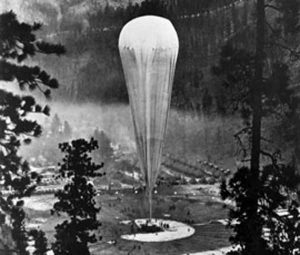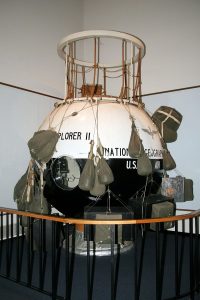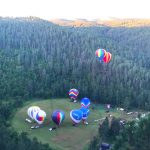
 In the Black Hills of South Dakota, south-west of Rapid City lies a natural depression in the Earth. Apparently, the depression is a sinkhole that has 700 feet deep cliff walls all around, that prevent wind from reaching the bottom. The windless part of the site is what makes it perfect for balloon launches. The site was noticed by the National Geographic Society and the United States Army Air Corps, who set up what they called Stratocamp in 1934-1935. Stratocamp was a joint effort code named Explorer to launch two manned giant helium high-altitude balloons capable of stratospheric flight. The crash of the Soviet Osoaviakhim-1 after setting a world record flight of 72,178 feet (13.71 miles), the Explorer program set a new goal…to beat that record. The first Explorer balloon was launched on July 28, 1934. The balloon made it 11 miles up before it disintegrated. Thankfully the astronauts onboard had parachutes on, so they survived.
In the Black Hills of South Dakota, south-west of Rapid City lies a natural depression in the Earth. Apparently, the depression is a sinkhole that has 700 feet deep cliff walls all around, that prevent wind from reaching the bottom. The windless part of the site is what makes it perfect for balloon launches. The site was noticed by the National Geographic Society and the United States Army Air Corps, who set up what they called Stratocamp in 1934-1935. Stratocamp was a joint effort code named Explorer to launch two manned giant helium high-altitude balloons capable of stratospheric flight. The crash of the Soviet Osoaviakhim-1 after setting a world record flight of 72,178 feet (13.71 miles), the Explorer program set a new goal…to beat that record. The first Explorer balloon was launched on July 28, 1934. The balloon made it 11 miles up before it disintegrated. Thankfully the astronauts onboard had parachutes on, so they survived.
The second balloon was launched in November 11, 1935, and ascended 14 miles up, before landing near White Lake, South Dakota. They had done it. That second flight set a world record that would not be broken until astronauts started flying into space. Astronauts, Air Corps Captain Albert William Stevens, Captain Arson Anderson, and Major William E. Kepner became the first men to view the Earth’s curvature. This exploration helped the Air Force build better planes and helped scientists build satellites.
In the 1950s, Project Manhigh and Project Strato-Lab launches were made from a man-made crater of an iron mining pit near Crosby, Minnesota, and if weather allowed, from Fleming Field in South Saint Paul, Minnesota. The Stratobowl was used as a backup location, if launches could not be made at the Minnesota locations. As it turned out, the Stratobowl was needed for a number of launches. The first such launch was on November 8, 1956, when the Strato-Lab I gondola lifted Malcolm Ross and M L Lewis from the Stratobowl to a world altitude record for manned balloon flight of 76,000 feet. There were also three Stratobowl launches in 1958, and seven in 1959. The most publicized flight was that of Strato-Lab IV, piloted by Malcolm Ross and Charles B Moore, which lifted off from Stratobowl on November 28, 1959. The balloon reached an altitude of 81,000 feet, and landed safely in Kansas after 20 hours in the air. The purpose of the flight was to perform spectrographic analysis of the planet Venus with minimal interference from the Earth’s atmosphere.
These days, the Stratobowl is usually seen from a popular hiking trail that takes you up to the rim…which is 
 how my husband, Bob and I first saw it. You can also drive down to the bottom, and there are festivals during which balloons are launched…to go to normal heights and to take tourists and owners for a normal ride. No records are set to be won, or experiments to be made. Still, looking at the Stratobowl from the top of the trail is very impressive, and while it is not a difficult or a long hike, we enjoyed it very much, and it is a short hike that I very much recommend. It was really interesting, and to think it is a sinkhole.
how my husband, Bob and I first saw it. You can also drive down to the bottom, and there are festivals during which balloons are launched…to go to normal heights and to take tourists and owners for a normal ride. No records are set to be won, or experiments to be made. Still, looking at the Stratobowl from the top of the trail is very impressive, and while it is not a difficult or a long hike, we enjoyed it very much, and it is a short hike that I very much recommend. It was really interesting, and to think it is a sinkhole.


Leave a Reply